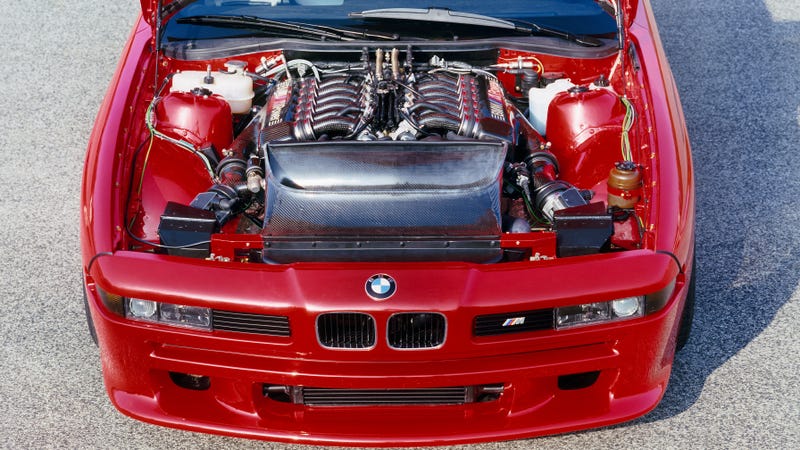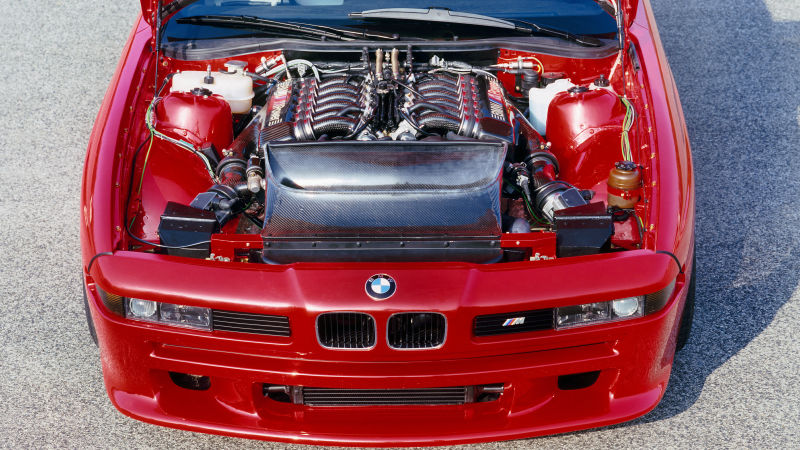
In 1987, BMW announced to the world that it was officially not screwing around anymore when it put a 5.0-liter V12 into production, setting a 300-horsepower standard for luxury and refinement. It was only a few years later that BMW would produce probably the ultimate V12, the 618-horsepower heart of the McLaren F1. But there was one engine sat in the middle that never quite made it into production, too big to live.
The car you’re looking at shouldn’t exist. It’s a prototype, and in most cases prototypes get crushed. But BMW never destroyed this one. I imagine it’s because nobody had the heart to do so.
This is the BMW M8 Prototype, a single vehicle built of what a true M car version of the original BMW E31 8 Series could look like.
Advertisement
The details of it are remarkably raw, particularly when viewed in the context of today’s all-wheel drive, automatic-equipped superlux M-branded SUVs and sedans.
Advertisement
The doors and wheel arches were carbon fiber. The windows were plexiglass. The pop-up headlights were deleted entirely.
New gauges read pressures to the driver, sat in a kevlar bucket seat with a body-strengthening B-pillar beside them, unlike the road car’s pillarless frame.
Advertisement
But the standout feature was the car’s engine. This is the 6064 cc “S70/1,” rumored to put out a good 550 horsepower, carbon fiber intakes running to twelve individual throttle bodies, cable-linked to the gas pedal unlike the drive-by-wire road car.
Advertisement
It is a sight to behold.
I requested these photos from BMW’s gracious historical archives, and I’ve never seen them anywhere else online. The engine looks like a black heart in the red prototype. It’s gleaming in its bay, absolutely monstrous.
Advertisement
I assumed that this was the engine that ultimately became the engine in the McLaren F1. After all, these M8 prototype photos are dated 1990, and it was only in 1993 that the F1 came out with its famous S70/2, displacing a very similar-sounding 6064cc. But then I turned up this passage in a BMW Blog write-up of the M8 prototype a few years back when BMW showed the car in its secret underground garage full of secret cars of great secrecy:
Interestingly, one of the biggest misconceptions of the M8 is that it shares an engine with the record shattering McLaren F1 as it was around the same time as the development of the M8 that McLaren commissioned BMW to build a very power V12 to power their supercar – after being denied by Honda.
Per our sources, the McLaren V12 (a modified S70) and the M8’s V12 were likely constructed by many of the same engineers hence a similar design and output but differed in areas such as overall length due to the horizontal intakes for a front engine layout if the 8 compared to the vertical intakes of a mid-engined car. The McLaren engine, from a design standpoint, shared quite a lot of characteristics and parts with the S50 engine of the E36 M3.
Advertisement
This all sounded a little vague, and things only got much more confusing when I asked BMW to clarify things.
First BMW sent me two links. The second was to the BMW archive’s official data sheet on the McLaren F1’s S70/2. The first was to the BMW archive’s official data sheet on the S70/1. Only this data sheet said that the engine was a 5.6 liter, putting out a good-for-its-time 380 horsepower.
I replied, saying that I’d read that the engine in the M8 was a 6064cc engine. Was I wrong?
Advertisement
No, I wasn’t, as BMW (de-)clarified. The S70/1 was also the name given to the engine that was also called the S70B56, the production engine for the BMW 850CSi. That was the S70/1, but it wasn’t the same S70/1 that was in the M8 prototype. I asked for more of an explanation as to how the engines were different, and BMW sent me back this in an email:
This topic is quite complicated. Therefore I would like to give you another help.
Please find the technical differences between “S70B56” and S70/2 enclosed.
The chronology of the engine was:
S70/1 was developed for the BMW M8
The S70B56 was developed for the BMW M850CSi (S70/1 and S70B56 are sometimes named the same but have different capacities)
S70/2 was developed for the McLaren F1 serial car
S70/3 was developed for the McLaren F1 GTR
Finally, the S70/3 was modified for the BMW V12 LMR and then called P75
I started to google around various combinations of “M8 Prototype” + “McLaren F1″ + “S70/1,” getting mostly posts and re-posts of that old BMW Blog article, until I found a familiar name on a forum post from the time: Peloton25. For those of you who are not students of the McLaren F1, Peloton25 knows everything there is to know about these cars. He has read every book, seen every car, met every engineer.
Advertisement
When one person on VWVortex supposed that the M8 Prototype’s engine became the heart of the unique McLaren F1, Peloton25 set the record straight:
Actually the final portion of your comment is not factual. It gets somewhat confusing, but try to follow paying close attention to each engine’s specific name in bold to make things more clear.
The standard 850i and 750i/iL BMW models used the M70 engine. It was a 5.0L V12 with one camshaft per cylinder bank and 24 valves that made around 300hp and was used from late 1989 until 1993. Later on in 1994 they would increase the displacement of the M70 to 5.4L creating the M73 which offered 326hp, at the same time changing the name of the car to the 850Ci. The M73 became the standard V12 engine until 1999 when 850 production finally ended.
From the original M70 BMW Motorsport developed the S70/1 in 1990 which they only built one of. It was close to 6.0L in displacement, had two cams per bank, with 48 valves total and reportedly made close to 550hp. This single engine was developed for the BMW M8 concept which never saw production.
In 1992 BMW also began offering the 850CSi which carried the S70 engine. It was essentially a single cam version of the S70/1, with 24 valves and a reduction from ~6.0L down to 5.6L. This engine was good for 380hp.
Backing up a little, the story goes that Gordon Murray’s old friend Paul Rosche, chief engineer at BMW Motorsport, approached him in 1990 at the Hockenheim Grand Prix to inquire about the engine plans for McLaren’s sports car project. At the time Murray still had not found a suitable powerplant for the F1 and he knew he was running out of time. Rosche offered up that his group could build the engine for the F1. It was at that time Rosche mentioned the 48V version of the 850’s V12 (S70/1) that they had been developing which he thought would suit Murray’s needs.
Quoting from “Driving Ambition”:
On October 25th, 1990, Gordon visited Munich. The hopped up production V12 would not do: “Too big and heavy. Definitely not for us. Then Paul asked ‘What do you really want?’, so I told him: big displacement in the smallest possible package-size — absolutley no more than 600mm long — revving to around seven-five — 550-plus bhp — maximum weight 250kg — rigid enough to work as a load-bearing structural member — dry-sump lubrication to minimize overall height and avoid surge in high-G cornering.
And Paul simply said ‘We’ll do a new engine’.”
Gordon had instructed the team of Motorsport engineers that power-to-weight was the bottom line and to consider that in everything that they did. “Never use a 10mm bolt when 9mm would do – consider weight as driving the design.” He could see them obviously thinking ‘who is this loony, telling us how to design engines?’ but Paul Rosche backed him up.
The final engine that Motorsport developed out performed McLaren’s 550hp target by 14 percent at 627hp. It met the 600mm length requirement, but with all necessary ancillaries, exhaust system and silencer it overshot the weight target by about 16kg. Gordon would forgive them that – 6.4 percent overweight was more than compensated for by 14 percent extra power of course. The first completed S70/2 V12 was delivered to McLaren for fitment to one of their test mules March 4th 1992.
Advertisement
We’ve used Driving Ambition before, a memoir from an engineer who helped develop the McLaren F1. It’s a trustworthy source, and a good explanation of how the M8 prototype fits into the BMW V12 timeline. It may have been the contender for the F1’s powerplant, but it was too big, physically big, to make it all work. It was an engine of extraordinary design, but the McLaren F1 needed to operate on a level above.
So the S70/1, the S70/1 in the M8, not the S70/1 in the 850CSi was great and wonderful and powerful and beautiful. But it was too much for any normal road car, and not enough for that high water mark of the McLaren F1. It ended up lost in the middle.
Advertisement
That’s kind of a shame. I wish I might just once hear it road, those twelve throttle bodies barking down some test track, running away.













